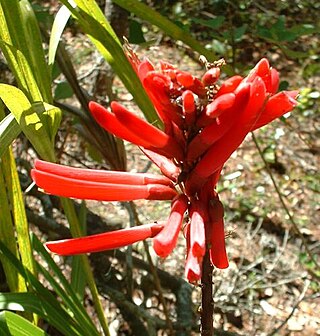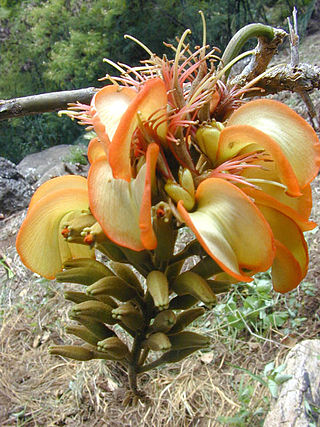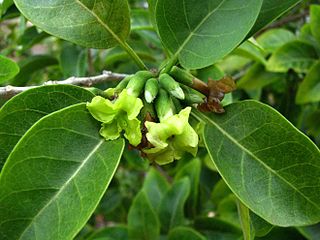
Erythrina is a genus of plants in the pea family, Fabaceae. It contains about 130 species, which are distributed in tropical and subtropical regions worldwide. They are trees, with the larger species growing up to 30 m (98 ft) in height. The generic name is derived from the Greek word ερυθρóς erythros, meaning "red", referring to the flower color of certain species.

Erythrina herbacea, commonly known as the coral bean, Cherokee bean, Mamou plant in South Louisiana, red cardinal or cardinal spear, is a flowering shrub or small tree found throughout the southeastern United States and northeastern Mexico; it has also been reported from parts of Central America and, as an introduced species, from Pakistan. Various other systematic names have been used for this plant in the past, including Erythrina arborea, Erythrina hederifolia, Erythrina humilis, Erythrina rubicunda, Corallodendron herbaceum and Xyphanthus hederifolius.

Wiliwili, is a species of tree in the pea family, Fabaceae, that is endemic to the Hawaiian Islands. It is the only species of Erythrina that naturally occurs there. It is typically found in Hawaiian tropical dry forests on leeward island slopes up to an elevation of 600 m (2,000 ft).

Erythrina variegata, commonly known as tiger's claw or Indian coral tree, is a species of Erythrina native to the tropical and subtropical regions of eastern Africa, the Indian subcontinent, northern Australia, and the islands of the Indian Ocean and the western Pacific Ocean east to Fiji.

Erythrina fusca is a species of flowering tree in the legume family, Fabaceae. It is known by many common names, including purple coraltree, gallito, bois immortelle, bucayo, and the more ambiguous "bucare" and "coral bean". E. fusca has the widest distribution of any Erythrina species; it is the only one found in both the New and Old World. It grows on coasts and along rivers in tropical Asia, Oceania, the Mascarene Islands, Madagascar, Africa, and the Neotropics.
Erythrina eggersii is a vine or tree in the family Fabaceae which is commonly known as cock's-spur, espuelo de gallo, or pinon espinoso. It is native to Puerto Rico, the British Virgin Islands and the U.S. Virgin Islands, where it is threatened by the act of habitat loss.
Erythrina euodiphylla is a species of legume in the family Fabaceae. It is found only in Indonesia.
Erythrina perrieri is a species of legume in the family Fabaceae. It is found only in Madagascar.
Erythrina schliebenii is a species of legume in the family Fabaceae. It is found only in Tanzania. The species is named for German collector and botanist Hans-Joachim Schlieben.
Erythrina tuxtlana is a species of legume in the family Fabaceae. It is found only in Mexico.
Fitchia tahitensis is a species of flowering plant in the family Asteraceae. It is endemic to the island of Tahiti in the Society Islands of French Polynesia.
Hernandia tahitensis is a species of plant in the Hernandiaceae family. It is endemic to French Polynesia.
Melicope tahitensis is a species of plant in the family Rutaceae. It is endemic to the island of Tahiti in the Society Islands of French Polynesia.

Nothocestrum breviflorum, commonly known as smallflower ʻaiea, is a species of tree in the nightshade family, Solanaceae, that is endemic to the island of Hawaiʻi. It inhabits dry and mixed mesic forests at elevations of 180–1,830 m (590–6,000 ft). These forests are dominated by ʻōhiʻa lehua and koa or lama, while plants associated with smallflower ʻaiea include wiliwili and uhiuhi. N. breviflorum reaches a height of 10–12 m (33–39 ft). It is threatened by habitat loss. It is federally listed as an endangered species of the United States. There are fewer than 50 individuals remaining.
Ochrosia tahitensis was a species of plant in the family Apocynaceae. It is endemic to Tahiti of the Society Islands, in French Polynesia.
Polyscias tahitensis is a species of plant in the family Araliaceae. It is endemic to the islands of Tahiti and Raiatea in the Society Islands of French Polynesia.
Premna tahitensis is a species of plant in the family Lamiaceae. It is native to the Bismarck Archipelago in Papuasia and some islands of the south Pacific: Fiji, the Marquesas Islands, Niue, the Pitcairn Islands, Samoa, the Society Islands, Tonga, the Tuamotu Islands, the Tubuai Islands, and Wallis and Futuna.
Psychotria tahitensis is a species of plant in the family Rubiaceae. It is endemic to the the island of Tahiti, in the Society Islands of French Polynesia.
Balaka insularis is a rare species of flowering plant in the palm family endemic to Samoa. It was formerly placed in the monotypic genus Solfia with the species name Solfia samoensis. It was placed in the genus Balaka in 2014.

The reddish myzomela is a species of bird in the family Meliphagidae. It is endemic to Papua New Guinea, where it is found on New Ireland and adjacent islands. Its natural habitats are subtropical or tropical moist lowland forests and subtropical or tropical moist montane forests.







